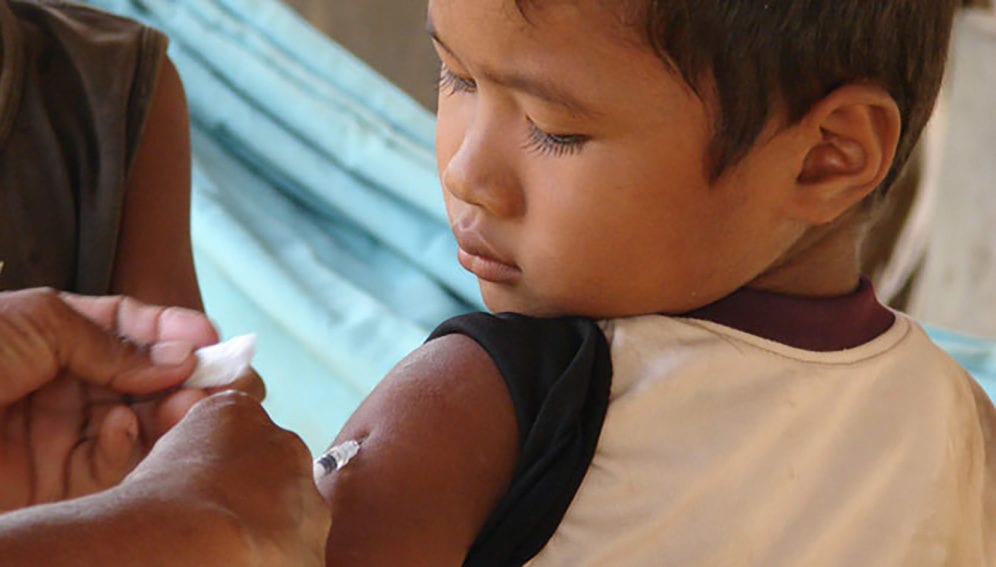20/09/19
Asia Pacific vows to eliminate measles, rubella by 2023

By: Sanjeet Bagcchi
Send to a friend
The details you provide on this page will not be used to send unsolicited email, and will not be sold to a 3rd party. See privacy policy.
[NEW DELHI] Amid a global upsurge in the incidence of measles, Asia Pacific countries have resolved to strengthen surveillance and immunisation programmes to eliminate the childhood viral disease, along with rubella, by 2023.
As of September this year, some 365,000 cases of measles had been reported globally — the highest number of cases since 2006, according to WHO. Except for the Americas, all regions have seen an upward trend in the incidence of measles, attributed to poor health systems and misinformation regarding vaccines.
“Eliminating measles will prevent 500,000 deaths a year in the [Asia Pacific] region, while eliminating rubella would avert about 55,000 cases and promote the health and well-being of pregnant [women] and infant”
Poonam Khetrapal Singh, World Health Organization South-East Asia Region
Measles is a highly contagious viral disease that initially infects the respiratory tract and then continues on throughout the body. It is transmitted through droplets from an infected person’s mouth, nose, or throat. Rubella is also a highly contagious viral infection. If it occurs during pregnancy, the virus can cause congenital defects in the baby or even foetal deaths. Both measles and rubella usually manifest with, among other symptoms, a fever and rashes.
“Eliminating measles will prevent 500,000 deaths a year in the [Asia Pacific] region, while eliminating rubella would avert about 55,000 cases and promote the health and well-being of pregnant [women] and infants,” said Poonam Khetrapal Singh, the New Delhi-based regional director of WHO South-East Asia Region, in a statement.
Measles does not occur in populations where vaccinations are greater than 92 per cent and outbreaks have been known to happen where immunisation rates have dropped, according to WHO. Vaccines can be standalone but typically come in combinations such as the measles-rubella (MR) vaccine or the measles-mumps-rubella (MMR) vaccine.
The 72nd session of WHO’s regional committee, held in New Delhi (2-6 September), resolved to eliminate measles and rubella by 2023 by improving defences at the national and sub-national levels, primarily through vaccination, establishment of laboratory-supported surveillance systems and quicker responses to outbreaks.
Measles has already been eliminated in Bhutan, Democratic People’s Republic of Korea, Maldives, Sri Lanka and Timor-Leste, but not in the other countries that come under WHO’s South-East Asia Regional Office, including India, Indonesia, Myanmar, Nepal, Pakistan and Thailand.
Since 2014, measles elimination and rubella control have been made a priority in Asia Pacific countries. Under a campaign that started in January 2017, nearly 366 million children have been administered measles-rubella (MR) vaccines.
In 2019, Myanmar and Thailand witnessed measles outbreaks, with 4,435 cases — 14 of which turned fatal — being reported in Thailand by 31 August. The Philippines and Vietnam also faced major outbreaks, with the former reporting 4,5847 cases in the July 2018–June 2019 period.
“This new commitment to eliminate measles and rubella from the region by 2023 extends the earlier target date of 2020 set for measles elimination and, importantly, adds a rubella elimination goal,” William John Moss, professor at the departments of epidemiology, international health, and molecular microbiology and immunology, Johns Hopkins Bloomberg School of Public Health, Baltimore, US, tells SciDev.Net.
According to Moss, hurdles to elimination of measles in the Asia Pacific countries include high population density, migration and the highly contagious nature of the virus. In remote or conflict-ridden areas, access to vulnerable children can be challenging with parents increasingly declining vaccination because of mistrust and the spread of misinformation through social media.
Walter A. Orenstein, professor of medicine, pediatrics, epidemiology and global health at the Emory University, Atlanta, US, tells SciDev.Net that to accomplish the target, political will would be critical, as well as resources to improve routine immunisation.Vaccine hesitancy is a problem and initiatives should be taken up to determine the causes and counter-measures, says Orenstein. “This would include developing coalitions with groups within populations to overcome the distrust and hesitancy.”
Sunil Vaidya, a scientist at the National Institute of Virology, Pune, India, says that the 2023 target is achievable through “the collective efforts of government and international agencies and by nurturing existing immunisation programmes, surveillance efforts and the laboratories”.
“Due to social and print media, vaccine hesitancy is increasing — strong actions should be taken up by the government authorities to avoid false messages regarding the vaccines for preventing measles and rubella,” says Vaidya.
This piece was produced by SciDev.Net’s Asia & Pacific desk.













